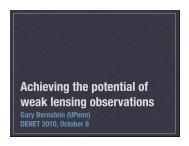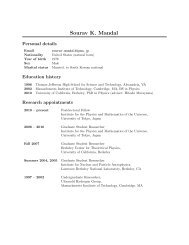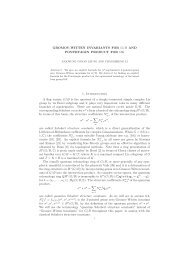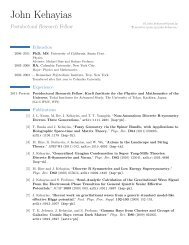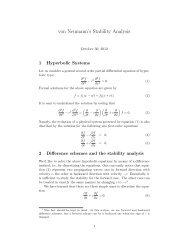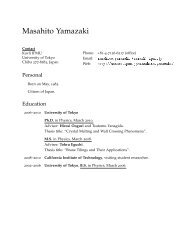STUDY SUMMARY - IPMU
STUDY SUMMARY - IPMU
STUDY SUMMARY - IPMU
You also want an ePaper? Increase the reach of your titles
YUMPU automatically turns print PDFs into web optimized ePapers that Google loves.
<strong>SUMMARY</strong> REPORT<br />
WIDE FIELD FIBER-FED OPTICAL<br />
MULTI-OBJECT SPECTROMETER (WFMOS)<br />
telescope environment and interfaces in critical locations and/or simple measurements to<br />
characterize the local environments.<br />
5. Some spectrograph gratings do not meet the delivery date. This schedule assumes<br />
delivery of all gratings is in time for integration and test. Sufficient testing and early<br />
integration can be done with a low-spec grating and/or a single accepted grating.<br />
6. Positioner Contractor unable to Perform. This acknowledges a single source for a critical<br />
deliverable. Mitigate with close monitoring and supplement with JPL resources if needed.<br />
This approach has been used often in the past with good success.<br />
7. Spectrograph aspherics difficult to manufacture. This risk is listed because only verbal<br />
quotes have been obtained from the vendors. It is expected to be addressed quickly by<br />
seeking alternate vendors as well as active involvement and management of the selected<br />
vendor.<br />
Risk decisions are supported by analyses and recommendations from the project team, but<br />
are ultimately made by the Project Manager in the same manner that all cost, schedule and performance<br />
impact decisions are made. If the scope of any change impacts Level 1 or 2 requirements,<br />
the management team, the advisory board, and Gemini are part of the decision process.<br />
The descope list provides the leverage for accepting reasonable risk and maintaining confidence<br />
that a meaningful instrument can be developed within the fixed budget even if many of the<br />
identified risks are actualized. The plan identifies functional or performance capabilities, which<br />
may be dropped at some later point of the project, allowing cost savings to be applied to the area<br />
where risks happened. It also describes where risks may be added (through dropping a test, or<br />
other activity with resulting cost avoidance) acceptably in order to cover unplanned costs in other<br />
areas. As with the risk list, the descope list will evolve through the instrument development and<br />
needs to be continuously assessed and updated.<br />
7.5 Reserves<br />
The total project reserves required is estimated at 20%; this 20% excludes the $8M allocated<br />
for the Subaru provided elements and does not factor in the Gemini-held contingency. The reserves<br />
are established by assessing risks associated with each WBS element (Management and<br />
Cost Volume, section 5.2). Higher reserves are allocated to areas that: 1) require more development<br />
effort and therefore have more uncertainty in meeting performance cost and schedule, 2)<br />
show risk of cost growth on procurements, 3) have a higher level of complexity in design or<br />
schedule coordination, and 4) have two or more identified significant risks at the project start.<br />
The reserves do not explicitly include an allocation for exchange rate uncertainty and instead a<br />
conservative exchange rate has been used to absorb rate fluctuations.<br />
Reserves above the partners’ contract-required 15% are held at JPL and managed at the project<br />
level to provide maximum flexibility in risk management. Allocation of reserves is a process<br />
that references the specific risk item and balances resources according to the summary of risks,<br />
schedule, and remaining resources. The project risks and reserves are reviewed and updated<br />
monthly with the project team and Gemini and quarterly with the advisory board. A clear assessment<br />
and justification for the release of reserves is developed with the subsystem leads to<br />
assess the impact across the instrument system. The final decision is made by the PM with concurrence<br />
from the PI. The advisory board will be notified of the potential for significant changes<br />
as they arise. A minimum level of reserves for each project phase is defined and managed to ensure<br />
sufficient funding is available through delivery. This is discussed further in the Management<br />
and Cost Volume.<br />
81



